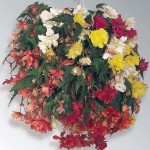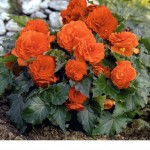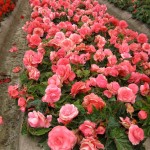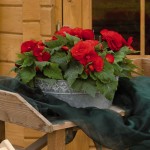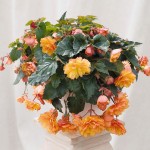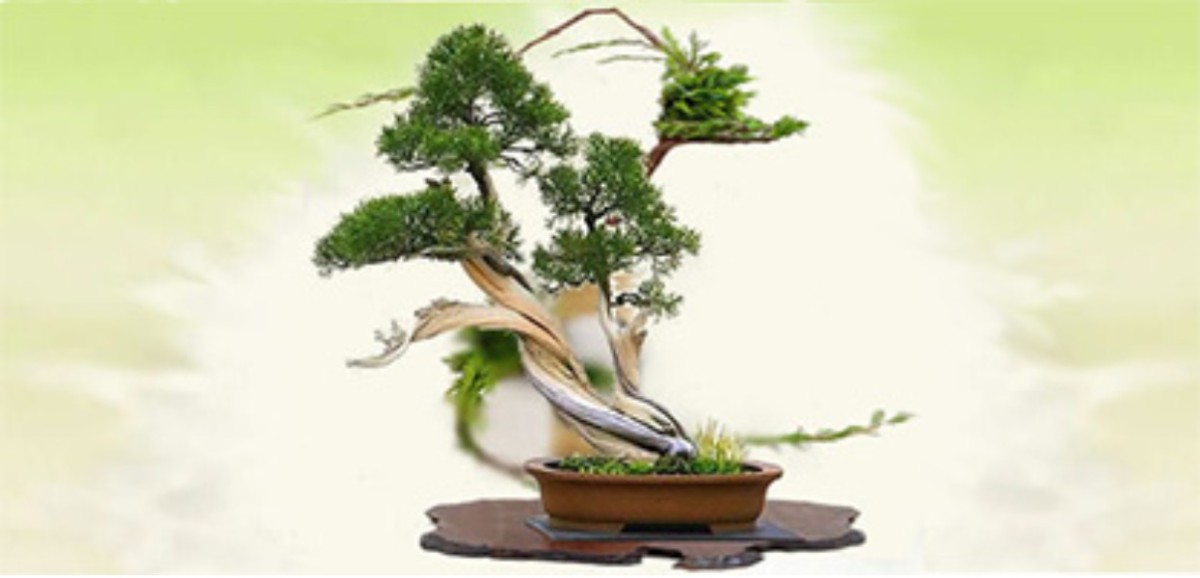Family: Begoniaceae
Distribution and habitat: Begonia tuberhybrida are a group of Begonia cultivars, regarded as some of the most spectacular of the genus. This is by the far the most widely grown type of tuberous begonias and it is also probably the most popular type of begonia worldwide. Over many decades of hybridizing work, various species traits were combined to create what we know as the tuberhybrida type today.
The Begonias are native to moist subtropical and tropical climates. In cooler climates,Begonia tuberhybrida plants are commonly grown indoors as ornamental houseplants or cultivated outside in summertime for their bright colorful flowers.
Description: Begonia tuberhybrida are grown for their handsome flowers. Plants truly characteristics of the group have swollen underground stem (tuber) and are deciduous with a period of total dormancy every year.
Begonia tuberhybrida forms usually have fleshy, erect stems up to 2cm (0.8 inch) thick and 38cm (15 inch) tall, with a few hybrids having a trailing habit. The soft easy damage, pointed-oval leaves 15-30cm (6-12 inch) long and 8-13cm (3-5 inch) wide are dark green but vein areas in some forms are a paler green. Flowers bloom in summer on 15cm (6 inch) long flower stalk arising from leaf axils. Male flowers are sometimes many-petaled and up to 15cm (6 inch) across, whereas female flowers are single-layered and up to only 5cm (2 inch) across. Flower colours is white or any shade of pink, red, yellow or orange.
All forms are dormant in winter.
Houseplant care: At the end of the growing season, the stem and leaves of deciduous Begonia tuberhybrida will gradually fall off. Do not pull away the stems since this could damage the tuber.
Use canes to support the heavy flowers stems.
Blooms will be encouraged to grow larger if all female flower heads are removed (these are easily recognized by the seed capsule behind the petals).
Light: Give Begonia tuberhybrida plants bright filtered light all year round. Light is not important during the dormant period.
Temperature: During the active growth period normal room temperatures are suitable for Begonia tuberhybrida. In temperatures above 18C (64F) stand pots on trays of moist pebbles or suspend saucers of water under hanging basket. During the winter keep dormant forms at a temperature of about 13C (55F).
Watering: Water actively growing plants moderately, allowing the top couple of centimetres (0.8 inch) of the potting mixture to dry out before watering again. As growth slows down, reduce amounts of water gradually. Stop watering when the foliage begin to turn yellow and plant start to loose their foliage for winter dormancy.
Avoid getting water on leaves and flowers except for occasional necessary rinsing for grooming purposes.
Feeding: Apply a high-potash liquid fertiliser to actively growing plants about once every two weeks. Stop feeding the plants which are going dormant.
Potting and repotting: Use either a peat-based mixture or a combination of equal parts of soil based mixture and coarse leaf mould. Put a shallow layer of clay-pot fragments in the bottom of pots for extra drainage. When potting or repotting, simply sprinkle some mixture around the tuber and roots and tap the container briskly to settle the mixture
Start the tubers of Begonia tuberhybrida forms into growth in early spring by planting several in shallow trays of moistened peat moss, setting the tubers (with the concave side upwards) half in and half out of the peat moss. Stand each tray in bright filtered light for about three or four weeks, when about 5cm (2 inch) of the top growth will have been made. Then move each specimen into an 8 or 10cm (3-4 inch) pot of the recommended potting mixture for adult plants. The large-flowered hybrids may need to be moved into larger pots two or three times during the summer, but most other kinds can spend the entire season in same container.
Gardening: The ideal conditions for tuberous begonias are areas where evening temperatures do not fall below 15C (59F) and where day temperatures are less than 27C (81F)(on average). These plants are a definite challenge in very warm climates. They prefer a mild summer climate and are totally intolerant of high temperatures or very high humidity levels.
The plants are quite brittle and staking helps them tolerate violent weather.
The single female flowers are removed before seed forms to keep the plant blooming. The females are on either side of the double male flowers.
In warm climates the tubers of these plants can be planted in fall for use as a cool season bedding plant.
Location: Begonia tuberhybrida grow best in partial shade. Exposure to excessive sunlight can result in burnt flowers and leaves. Too much shade results in foliage that is very lush with few flowers.
Soil: Begonia tuberhybrida plants need rich, well-drained soil with high organic matter. Amend the soil with leaf mold or peat moss.
Plant the tubers "eyes up" indoors in early spring in flats of peat moss and sand. Place the trays in a dark location at 18C (65F) until 3cm (1inch) tall shoots appear. Cover the shoots with additional mix and move the trays to a lighted location at the same temperature. Plant them outdoors after all frost danger has passed.
Plant Begonia tuberhybrida with 15 to 30cm (6-12 inch) space between them.
Irrigation: The plants need frequent watering, but excess causes flower bud drop. Allow soil to dry between waterings. Stop watering when leaves start to turn yellow and the stems begin to fall. Do not remove stems at this time.
Fertilise: They should be fertilized weekly with quarter strength fertilizer during all their active growing period. Stop fertilizing when plants shows signs of winding down or a month or so before you expect them to go dormant.
Dormancy: The tubers are dug when the leaves and stems fall off. Do not break off the stems, but wait until they fall off naturally. Injured bulbs should be exposed to air to allow the area to dry. Wash tubers and allow them to dry before storing. Dried tubers are covered with peat or sand and stored at 7 to 15C (45-60F).
Propagation: To propagate Begonia tuberhybrida forms cut a large tuber into two or more sections in the spring, making sure that each has a growing point. Treat the cut ends of the sections with fungicide to prevent root.Allow the pieces to dry several days and then pot each one exactly as if it were a whole tuber. Pinch off the first flower buds.
Alternativelly take a stem cutting. Stem cuttings are made from surplus shoots which arise from the tuber. Stem tips may also be used. The cuttings are 8cm (3 inch) long and are cut off just below a node. Sand may be used as the rooting media. Keep cuttings out of direct sun and in temperatures between 15 to 18C (60-65F). Rooting occurs in five weeks.
Problems: Begonia tuberhybrida haslong-term health usually not affected by pests.
Tubers will rot if they are too wet prior to planting.
Treatment: Keep them in an airy cool place over winter (do not expose to frost).
Begonia tuberhybrida plants can also rot if over-watered.
Yellow leaves are a result of either too much or too little water.
Leaf loss may be caused by lack of light if stems are thin and leggy, too much heat if leaves are dry or too much water if leaves are wilted and rotten.
Loss of buds and leaves turning brown at the tips are usually caused by lack of humidity.
These plants are susceptible to powdery mildew (a white powder that forms on the leaves) caused by bad ventilation.
Treatment: Improve the air circulation or use a suitable fungicide as a preventative measure.
Thrips cause irregular reddish brown lines on the upper sides of the leaves. Spots form on the undersides of the leaves, especially along the main veins. The leaves may be deformed.
Black vine weevil grub eats the roots causing wilting and death.
Mites stunt the new growth.
Treatment: Use a suitable pesticide that treat each of these pests effectively.
Avalability: Begonia tuberhybrida plants may be available as either a mature, blooming plant or dormant tubers.
Uses and display: Begonia tuberhybrida group are temporary plants making spectacular displays for the summer and autumn. Begonia tuberhybridaare usually grown in pots, but there are also hanging basket varieties. Begonias can be grown in a sheltered shadehouse, on a veranda, in a sun room or on a window ledge.
Height: 38cm
Hardiness zone: 10a-11
